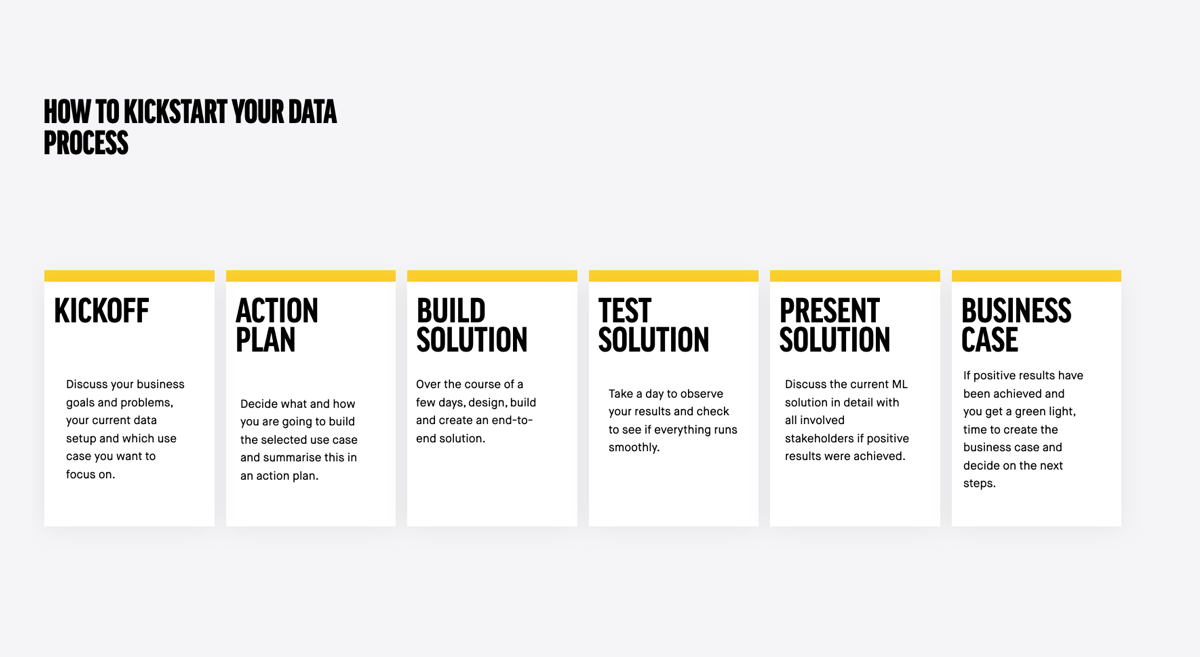Kickstart your data practice in a week

Nowadays, most companies have an abundance of data which comes from multiple sources, at their disposal. Now, many of us store our data in the cloud or in a Data Management Platform. However, simply storing data is not enough to bring value to it. In order to take your data to the next level, brands need to leverage their data to activate and monetise it. But how do you start? Start small, tackle a specific challenge and create a proof of concept in a week’s time.
A week to implement a proof of concept
Tackling a data problem in a week may seem daunting, but working under a strict time constraint towards a specific goal can yield powerful results. In order to start, brands should decide which business goals they want to tackle first. Now is not the time to aim for the moon as you’re trying to implement a new system in a week to establish its value. Instead, It’s recommended that companies pick an easy and realistic problem which they have been meaning to undertake for some time. Next, with a small team of experts, create an action plan. There is no need to have everything figured out now, just designate roles and responsibilities and a clear overview of what should be achieved each day. Once this is done, the process of building or implementing the desired solution can begin. The last step is to evaluate the worth and value of your solution before presenting it to your company’s managing directors.
You may find that the solution you had in mind doesn’t work or, even better, the implemented solution solves multiple problems. The advantage of a quick proof of concept is that companies don’t need to invest a large amount of money or have a proper business case to see whether they were able to successfully tackle a specific challenge.

Data problem which can be fixed in a week
It can be overwhelming to know where to start or which problems to tackle. However, below are the five most common data problems which brands could tackle in a week’s time.
Predictive retargeting– Most of us want to avoid retargeting irrelevant website visitors who are not interested and will not convert. Most companies retargeting audiences are constructed using gut-feeling or defined by simple rules such as “all people that have visited the website” or “all visitors that have viewed a product”. However, brands can leverage raw clickstream-data and machine learning techniques to build a model that can predict the conversion intent of an individual website visitor in real-time. By doing this, this results in an improved brand reputation since only the customers that are interested in media attention are targeted. But also, improved budget allocation since brands will no longer divulge resources towards visitors who will not convert.
Demand forecasting – Many businesses encounter the issue of both over and underselling and seek innovative ways to deal with that, as any of these scenarios could have a primarily negative outcome for the company. For example, in the recruitment industry, you do not want too little applications for a vacancy because this increases the probability that you cannot deliver new employees. On the other hand, in the travel industry, it costs money when a type of accommodation is not booked and thus left unrented. Additionally, you do not want to invest your marketing budgets in vacancies or accommodations that will most definitely be filled or sold. Luckily, with demand forecasting, this can be avoided. Demand forecasting can enable brands to predict the expected demand for the upcoming 52 weeks which can help dictate which items to push via their marketing channels.
Pagespeed optimisation– Nobody likes a slow website. That’s why increasing the page speed is on every website owner’s to-do-list, especially if you’re an e-commerce brand because losing visitors is bad for business. Companies can leverage the data at their disposal to predict visitor behaviour in real-time. You can do this by recognising browsing patterns based on historical data and predict the next page in real-time. So when a visitor behaves in a similar pattern, the next page is automatically being prepared by your model in the background. This will increase the customer experience and conversions.
Conversion uploads– The main objective of performance marketing is to maximise value with a positive Return On Investment (ROI). To do this, it’s crucial to measure the actual value your campaigns are delivering. However, setting up accurate measurement for your campaigns can be quite complex. Because of this, fixed measures like selling price or pre-calculated lead values, are often measured by using conversion pixels. But by using conversion uploads, brands can set up a process which automatically uploads actual conversion data from your data warehouse to your digital marketing channels.
To make this a reality, brands need to match clicks to conversions in their data warehouse. You can do this by matching each unique click identifier to a conversion identifier. After creating a dataset with these Click IDs and values, you can upload this data automatically to your digital marketing channels. Subsequently, you can activate this data by adjusting your bid strategies towards this improved value. By using conversion uploads, there are endless opportunities to activate value data within your marketing channels.
From nothing to something in a week’s time
The above solutions may sound like big projects, but by breaking down the process and building a simple proof of concept in a week’s time, your company can harness its data to enhance the customer experience and increase business value. You may even discover that one solution could fix multiple problems you had. It’s all about starting small, experimenting and making the business case.
More Insights?
View all InsightsQuestions?
Director, Data & AI



